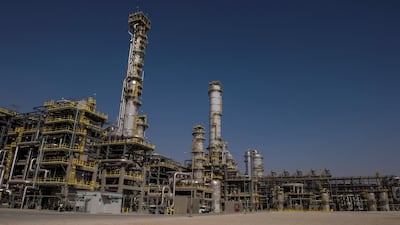The chemicals industry contributed to around US$43.8bn to the GCC economy in 2016 as countries in the region advance mega-projects targeted to meet growing demand from Asia, according to the Gulf Petrochemicals and Chemicals Association (GPCA).
The growth - the fastest in five years - was driven by capacity additions from Saudi Arabia, which has since the oil price slump looked at greater downstream integration with plans to build major refining and petrochemicals facilities.
Chemicals output from GCC oil producers grew at 8.5 per cent, reaching 158.5 million tonnes, according to GPCA, a body representing the downstream industry in the region.
Capacity additions by the world’s largest oil producer Saudi Arabia increased 12.7 per cent year-on-year, as new products, such as speciality chemicals were added to the product stream.
On Sunday, the state-owned upstream operator Saudi Aramco and the downstream operator Sabic, the region’s largest listed company, signed an agreement to build the region’s biggest oil-to-chemicals plant valued at $20bn on the western Red Sea coast.
The venture by the oil and chemical juggernauts will develop a 400,000 barrel-a-day refinery to process 9 million tonnes annually of chemicals and base oils. The project will be integrated with an existing 240,000 b/d refinery at Yanbu.
The Aramco-Sabic venture is set for completion by 2025, which is also the targeted timeline for completion of large-scale petrochemical facilities in the UAE, Kuwait and Oman.
____________
Read more:
Sabic chief calls for Saudi petchems firms to merge
VAT may dampen petrochemical sales, analysts say
____________
Abu Dhabi plans to almost triple its petrochemicals production to 11.4 million tonnes from 4.5 million tonnes by 2025 as part of its 2030 strategy. Oman is also looking to become a leading regional products producer though its $6.5bn Liwa Plastics Industries Complex as well as having plans for possible petrochemicals expansion at its upcoming Duqm free zone.
Kuwait also aims to develop an olefins and aromatics complex after the completion of its 615,000 bpd refinery at Al Zour.
Abdulwahab Al Sadoun, the secretary general at GPCA notes that the region’s mega projects have solid fundamentals supporting their growth and are not just strategies to foster job creation in the region’s rentier economies.
“Mega projects are not primarily developed for job creation. International banks won’t put money unless there are feasibility studies undertaken to realise these projects,” he said in Dubai.
“Petrochemical demand is driven by population growth from Asia, China in particular. The growth of the middle class [in these countries] creates more demand for such products,” he added.


